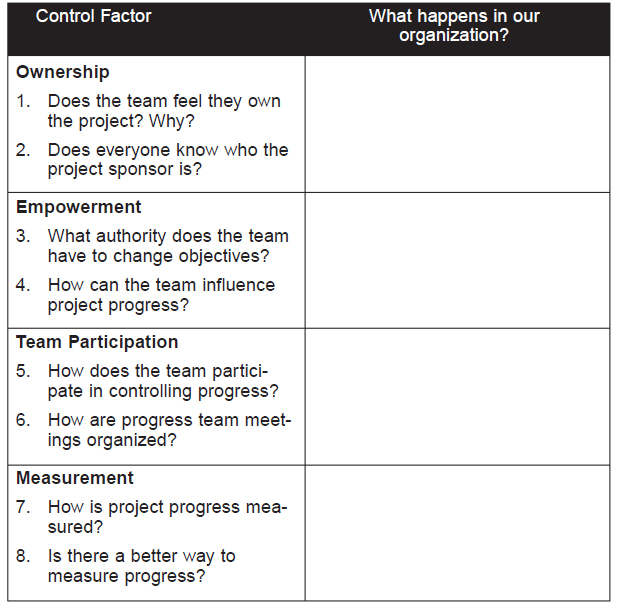8 |
Project stage 4: control |

Figure 8.1 Control
Maintaining control
 |
Do not let yourself lose focus. Regularly review your progress against the project plan (baseline) and focus, focus, focus, focus on reaching your goals. (Phillip Obraztsov, Regional Manager, Microsoft) |
It is during this stage of a project that the majority of work is carried out by the team to meet the objectives. The project manager has to constantly keep the team focused on the deliverables and ensure that progress is tracked and reported on.
Maintaining control on a project has two very different aspects:
- process control
- environmental control.
Process control refers to the physical processes put in place to control the project. These include activities such as recording time sheets for tracking progress, preparing progress reports, managing change requests, holding reviews and replanning meetings. Process control needs to be enforced, and the rules for team discipline need to be clearly defined and understood.
Environmental control is about creating a working condition that makes the team feel that they own the project, understand the level of empowerment they have in making decisions, and a feeling of responsibility for delivering the project objectives.
The combination of process control and environmental control provides a balance between enforcement and encouragement.
Process control
Figure 8.2 gives an overview of the processes for controlling a project. The project plan is the baseline from which progress is measured and adjustments to the original plan are made. Clear rules on how information is gathered, and when control events take place need to be defined and then implemented. Each person involved in the project must understand their role and responsibility towards controlling the project. Each part of the control process will now be discussed.
Track progress
 |
Have a good understanding of what your team members are currently doing and where they are with regard to the agreed deliverables. (Andreas Schmidt, Business Information Manager, Novartis) |

Figure 8.2 Overview of the project control process
Tracking progress is the first task that needs to be done to control a project. Regular reference to the project plan is necessary to control timescales, costs and the quality of deliverables. Timescales and costs are usually controlled by using time sheets, where team members record actual time spent on tasks. This actual time, or effort, spent on completing tasks will drive costs.
 |
If the total time spent on a task called ‘Interview in London’ was five hours, then the cost can be determined by multiplying the resource rate with the time spent. |
Time sheets are only part of the process of tracking task progress during a project. What the project manager must put in place is a method of asking each team member to confirm how long it will take to complete the remaining tasks. This is as important as asking them for the time they have already spent on a task.
 |
If the plan records a task called ‘Desk Research’ requiring an estimated five days to complete, the time sheet filled in by a team member may be two days. These two days will allow the project manager to determine costs, but it does not follow that three days are needed to complete the task. What would happen, if the team member now believes the task is much more complex than was envisaged when the plan was initially created? What if the team member now believes that the task will take a further five days and not three days to complete? Project control is lost if the new estimate is not recorded and the plan adjusted accordingly. |
New estimates to complete the remainder of each task need to be collected from each team member and the analysis matrix and time activity charts updated. The end date of the project may well have changed as a result of this new estimation. The most important factor here is that the information is collected and recorded so that the impact on the rest of the plan can be managed.
Progress reports
 |
Watch out for early warning signs of a project in trouble: missed completion dates, poor quality, and requests for additional time, resources and funding. (Gabriel Williams RIBA, Managing Partner, Petersen Williams Architects) |
While data from the team is collected to track progress of the project, a regular progress report needs to be prepared and circulated to the project sponsor. The same report could also be circulated to the steering committee members and team members. An example of a progress report can be seen in Chapter 9, Figure 9.8. At the top of the form is the usual information showing the project name, report date, project manager name, sponsor name and the list of people who will receive this report. These are followed by the budget section that compares the planned spending with the actual spend. Any request for additional budget is also recorded so that financial control of the project can be maintained by the sponsor.
Any unforeseen issues are reported in the issues section followed by a list of tasks that were completed. Any tasks that were not completed are then listed, together with a brief explanation. Finally, any new requirements or additional tasks are recorded.
Reviews and change control
In addition to tracking progress and preparing regular progress reports, a process must be put in place to control change. Quite often, this change process does not exist and changes are implemented without considering the impact on the plan. Referring to Figure 8.2, change requests need to be recorded and discussed at the regular review meeting. On small projects where there is no steering committee, the project manager presents the change requests to the sponsor, who then either accepts or rejects the change. The project manager then needs to update the analysis matrix and time activity charts. On larger projects, the steering committee together with the sponsor accepts or rejects the changes requested.
The process of managing change allows the sponsor to control the costs, timescales and quality of deliverables. On some projects, where significant numbers of change requests are made, a change control manager may be assigned the task of managing this process on behalf of the sponsor and steering committee.
An example of a change request form can be seen in Chapter 9, Figure 9.7. This form will act as a method for recording change requests and its main section describes the request and the benefit to the user and business.
The frequency of holding review meetings with the sponsor and steering committee during the control process is shown in Figure 8.3.
Replan
The final step in the project control process is to replan, that is, to update the analysis matrix and activity time charts. This updated plan is then communicated to the sponsor and team members.

Figure 8.3 Frequency of meetings with project manager
Environmental control
 |
Have close contact with your team members and empower them as appropriate. Seriously consider the opinion of your team. Try to get the project (e.g. the scope and timetable) owned by the team. (Andreas Schmidt, Business Information Manager, Novartis) |
Creating the right environment, or working conditions, where the team feels it owns and is responsible for the project is not created through force, but is created through encouragement, discussion and thought.
The project manager needs to know that the project management process, or methodology, is totally understood by the team, and that they ‘buy into’ this process. The team members need to understand everyone’s roles and responsibilities, and why the project was commissioned. The first step in achieving these objectives is to present the terms of reference to the team and discuss people’s roles and responsibilities.
These discussions can be followed by a short workshop where the team is asked to consider answers to the questions presented in Figure 8.4. The discussion that these and similar questions generate will provide the answers the project manager needs to create the right environment for controlling the project.

Figure 8.4 Environmental control of a project
